

What Is Differentiated Instruction? Click the "References" link above to hide these references.
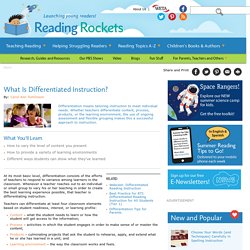
Csikszentmihalyi, M. (1997). Finding Flow: The Psychology of Engagement with Everyday Life. New York: Basic Books. Danielson, C. (1996). Enhancing Professional Practice: A Framework for Teaching. Sternberg, R. Using Differentiation As Tool For Behaviour Management - Generalscience Resource. A reflective article I wrote purely based on my teaching including various research My second school placement involved attending a larger than average, secondary school located in Rochdale called Falinge Park High School.
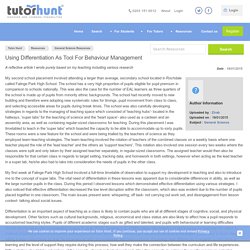
Reducing Behavior Problems in the Elementary School Classroom: Recommendation 1: Identify the Specifics of the Problem Behavior. Reducing Behavior Problems in the Elementary School Classroom Every teacher experiences difficulty at one time or another in trying to remedy an individual student's behavior problem that is not responsive to preventative efforts.
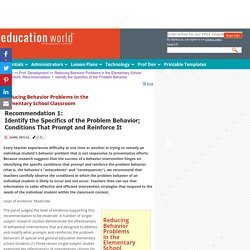
Because research suggests that the success of a behavior intervention hinges on identifying the specific conditions that prompt and reinforce the problem behavior (that is, the behavior's "antecedents" and "consequences"), we recommend that teachers carefully observe the conditions in which the problem behavior of an individual student is likely to occur and not occur. Teachers then can use that information to tailor effective and efficient intervention strategies that respond to the needs of the individual student within the classroom context. Level of evidence: Moderate. The importance of guided practice in the classroom. "Most of all, a man tends to imitate himself. The fact that he has done a thing once, in a certain way, makes it easier for him to do it again in the same way.
The oftener this is repeated, the more fixed does the habit become. At last he cannot do the thing in a different way without great effort. Finally it may become almost impossible for him to do it in a different way. " The importance of guided practice in the classroom. (266) The power of student-driven learning: Shelley Wright at TEDxWestVancouverED. Limitations and Benefits - Gradual Release of Responsibility. Limitations.
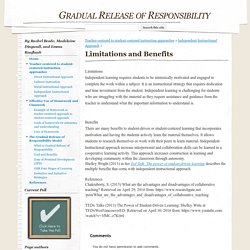
5a52c41b7b8f3f38db934aafe5412f78b7c8. Modeling Your Class Expectations. Modeling rules, as I said last week, involves demonstrating the specific behaviors and language patterns of an expectation in a way that grounds the rules in day-to-day experiences.

As teachers, we act out the desired behaviors, showing what each looks and sounds like. Below are the eight procedures for modeling and practicing expectations based on classroom rules. How Classroom Assessments Improve Learning. Maintaining Classroom Discipline. Promoting Good Methods of Classroom Discipline Helping students to govern their own behavior in ways that help them learn is a longstanding goal of all teachers.
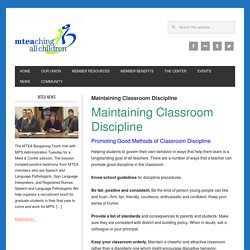
There are a number of ways that a teacher can promote good discipline in the classroom. Understanding Three Key Classroom Management Theories. The Key to Classroom Management. Team-Building Games and Activities for the Classroom. Team-building games and activities are a great tool for helping students learn to work together, listen carefully, communicate clearly, and think creatively.
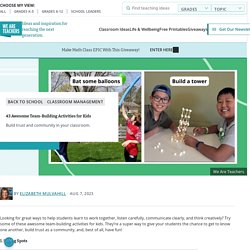
They also give your students the chance to get to know each other, build trust as a community and, best of all, have some fun! Here are 33 team-building activities that will teach your students these skills and more. Watch the video below to see three of our favorite team-building games in action, then read on for more ideas. [embedyt] 1. This activity requires strong verbal communication and cooperation. Getting to Know Each Other. Getting to know your students at the beginning of the year is crucial in establishing a strong teacher-student rapport.
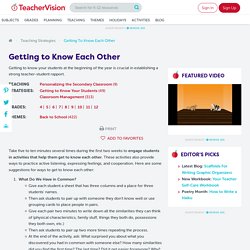
Take five to ten minutes several times during the first two weeks to engage students in activities that help them get to know each other. These activities also provide ways to practice active listening, expressing feelings, and cooperation. Listening to Students. Last week, my son's third grade teacher sent home what at first glance looked like a long homework assignment -- three sets of survey questions with many lines for his responses.
After reading the directions, we learned that I was to ask him the questions and transcribe his responses. Each night we settled down for what turned into a thoughtful, reflective conversation about my child: his reading preferences, learning style, interests, likes and dislikes, fears and hopes. I thought I knew my kid, but I was surprised by some of his responses -- "What distracts you more -- sound or movement? " one question asked. "Movement, definitely," my son said. "What's one thing you're afraid of? " How To Build Effortless Rapport With Students. Because it’s one of the most effective and most powerful ways to influence behavior, having a natural, trusting rapport with your students is crucial.
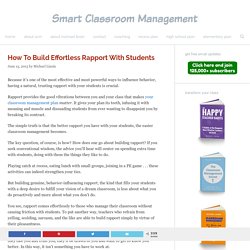
Rapport provides the good vibrations between you and your class that makes your classroom management plan matter. It gives your plan its teeth, infusing it with meaning and muscle and dissuading students from ever wanting to disappoint you by breaking its contract. The simple truth is that the better rapport you have with your students, the easier classroom management becomes. 4 Quick Ways to Build Rapport With Students. Seventy high schoolers I’ve never met are either staring at me or pretending I don’t exist. I’ve come 750 miles from my home in Kalamazoo to spend a day teaching this diverse group of at-risk freshmen and sophomores.